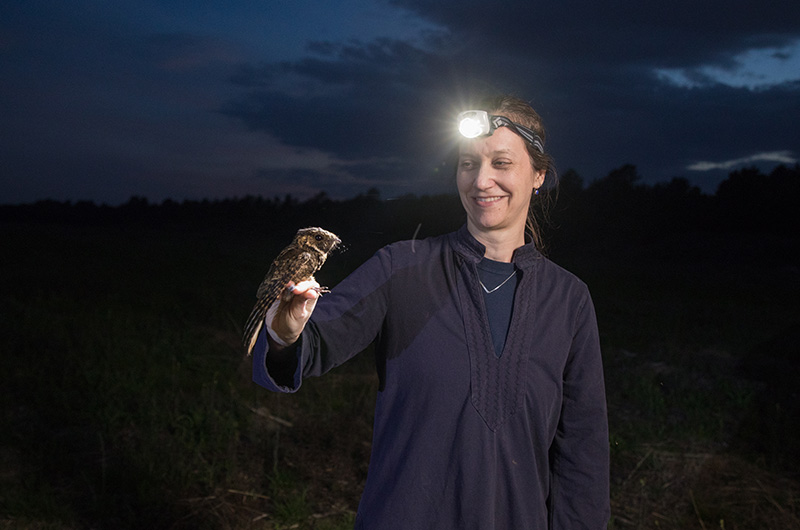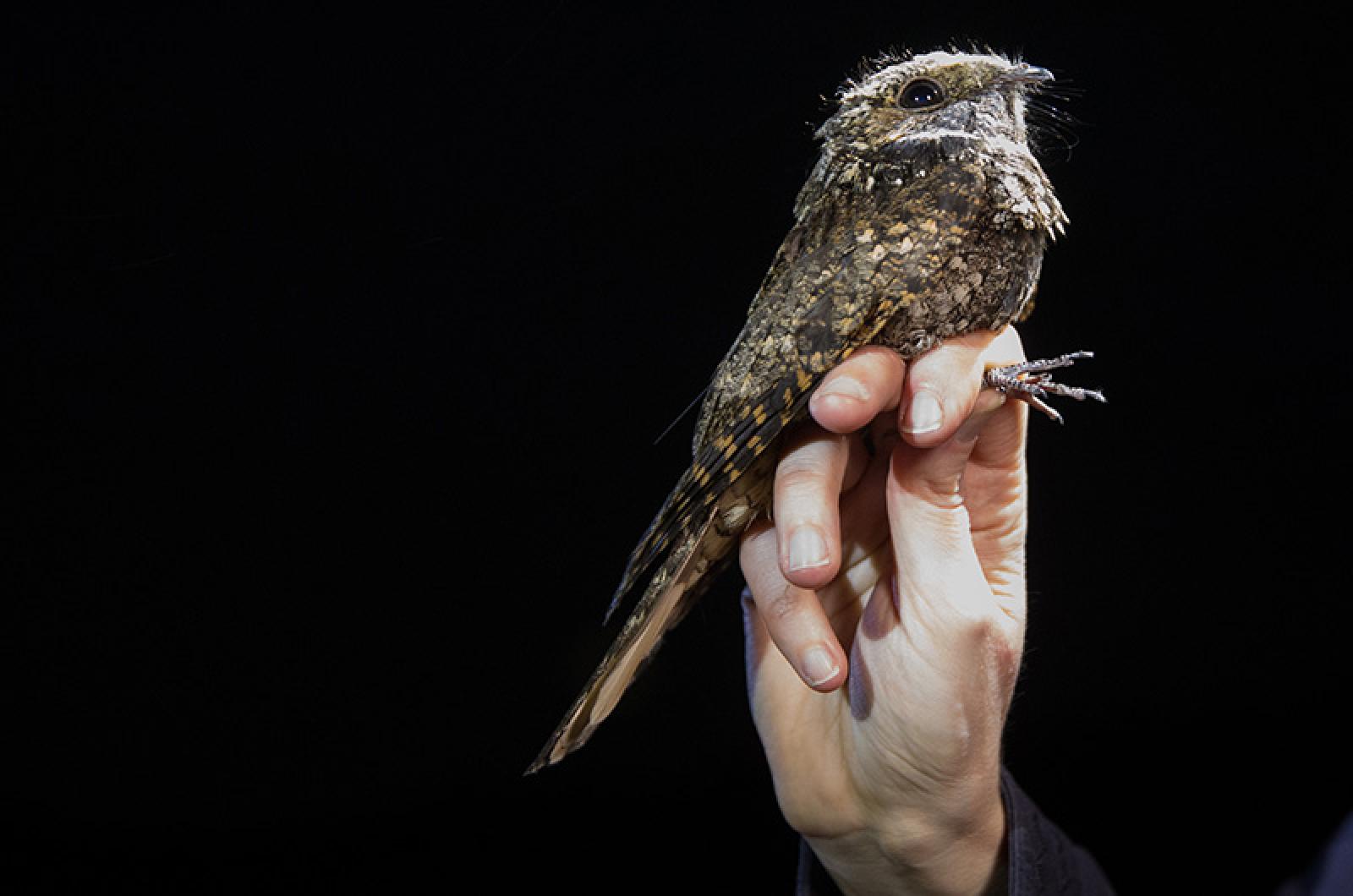Much has changed on the Vineyard since the early 1960s. Back then Chappaquiddick was merely an island, not an incident. Jaws referred to a mandible, not a man-eating shark. And Vineyarders Islandwide went to sleep with the eponymous song of the whippoorwill chirping in the background.
Although the days of Kennedy car crashes and Spielberg adventure films on the Island are likely over, the Manuel F. Correllus State Forest on Martha’s Vineyard remains one of the six strongholds in the state for the whippoorwill, a notoriously elusive, ground nesting nocturnal songbird.
“It’s an iconic bird,” said Island ornithologist Robert Culbert who writes the weekly bird column for the Gazette. “There’s only one species of bird that yells its name incessantly.” Mr. Culbert remembers the days when he used to hear whippoorwills from his front porch in Oak Bluffs at dusk. He was close enough to the birds that he could hear the faint “chuck” note at the beginning of their quick, haunting three-note calls. Today unless he’s at the entrance to the state forest, or playing disc golf, he says he is lucky to hear them at all.

Habitat loss and the introduction of skunks and raccoons to the Island has led to a steady decline in the whippoorwill population for the past half century. The sweet spot for the bird on the Cape and Islands was during the 1950s and 1960s, when open forests, pine groves and shrublands that they like to use as breeding grounds were abundant. By the 1980s the sparsely-populated forests and shrublands began to be developed and the call of the whippoorwill, once commonplace on the Vineyard, became rare. In 2011 Massachusetts designated it as a species of special concern. Since then, biologists at the state level have enlisted local volunteers to help study and stabilize the population in the regions where it still thrives.
Vineyard residents have been central to the effort.
Beginning nearlly a decade ago Chris Buelow, a restoration ecologist with the Massachusetts Natural Heritage Program, recruited Marilyn Miller and Ron Zentner through Mass Audubon to create, track, and monitor survey routes for whippoorwills. The first route ran 10 miles through the Correllus state forest, over Barnes Road and down to Long Point, with stops at each mile where the volunteers listen for the whippoorwill’s call.
“I never heard a whippoorwill before in my life,” said Mr. Zentner, who grew up in New York and has volunteered on the route since 2008. “I’d heard the name, of course, but the first time I really heard one was looking out for it at night.” Over the years, Ms. Miller and Mr. Zentner have fine-tuned their route, ensuring optimal sound quality to listen for the calls. They often hear a dozen different whippoorwills along the state forest trail. “That doesn’t sound like a lot,” said Mr. Buelow, “but when you’re talking about a rare bird species in the state, that’s actually a good number for whips.”
“It is kind of exciting the first time you hear them. You hear it and you’re like, there you go,” Mr. Zentner added.
Mr. Buelow and his associate at Mass Audubon Suzan Bellincampi praised the work of the volunteers. “The Correllus route was one of the first that we established, and that’s one of our most productive routes in the state,” Mr. Buello said. There are now more than 40 routes that volunteers monitor, including three new ones on the Vineyard that started this year.
“More people than I ever thought were interested,” Ms. Bellincampi said. “We were able to divide and conquer, because we have such an incredible core of volunteers.” Although they haven’t registered any whippoorwills on their up-Island route, which weaves east from Menemsha Hills toward Lambert’s Cove, the crew have had surprising success with the new routes in Chappaquiddick and at Katama.
“It’s an exciting success story,” Ms. Bellincampi added, “because although the bird is still struggling, there are people watching for it, and the results of this will help the land managers protect the animal. This is the kind of work that really matters.”
Statewide, Mr. Buelow said protecting the whippoorwill is more important than simply preserving a bird. “It’s a flagship species, so we are using it as a benchmark,” he said. “When we see a positive increase in whippoorwills, that’s a proxy for everything else we are doing there.”
He said much of the species’ decline can be tracked to increased fire suppression in the mid-20th century. But in places where controlled burns take place, such as the state forest, the bird has remained.
The preservation of whippoorwill populations has also allowed scientists to study their migration patterns. Marja Bakermans, a researcher at WPI who focuses on migratory songbirds, began a study last year where she outfitted whippoorwills with geolocator backpacks to track the exact spots where the birds winter.
“This species is particularly challenging to work with because of their cryptic, well-camouflaged, crepuscular nature,” Ms. Bakermans said. She lures the birds into mist nests by playing their call, then ties on the backpacks and takes down other physical measurements, all in the dead of night. Ms. Bakermans assured that the backpacks aren’t heavy, and she uses stretchy twine so the birds can grow or shrink.
“We don’t have a lot of information about their migratory routes,” she said. “Do they travel to the same locations, or do they spread out in their winter grounds?” Although she hasn’t had the chance yet to analyze her data, she said her work wouldn’t be possible without the 10-plus years of whippoorwill numbers from volunteers like Ms. Miller and Mr. Zentner.
“Understanding where the birds are and developing local partners is so important to conservation,” Ms. Bakermans said.
This year may be Ms. Miller and Mr. Zentner’s last for tracking the Correllus route. “I’m 70, and Ron’s 72,” Ms. Miller said. “We see the writing on the wall. We really enjoy doing this because it’s such a special experience. We had mixed feelings about stopping it, but at a certain point you have to step away.” Last week, the duo did a training session with younger volunteers, and now have five people who are ready to take over.
“Hey, more people can get interested now,” Mr. Zentner said.







Comments (16)
Comments
Comment policy »